This Resolution stipulates the arrangement of provinces and centrally-run cities (provincial-level administrative units) and the arrangement of communes, wards and towns (commune-level administrative units) in 2025 according to the resolutions and conclusions of the Central Executive Committee, the Politburo and the Secretariat on continuing to arrange the apparatus of the political system, arrange administrative units and organize two-level local governments.
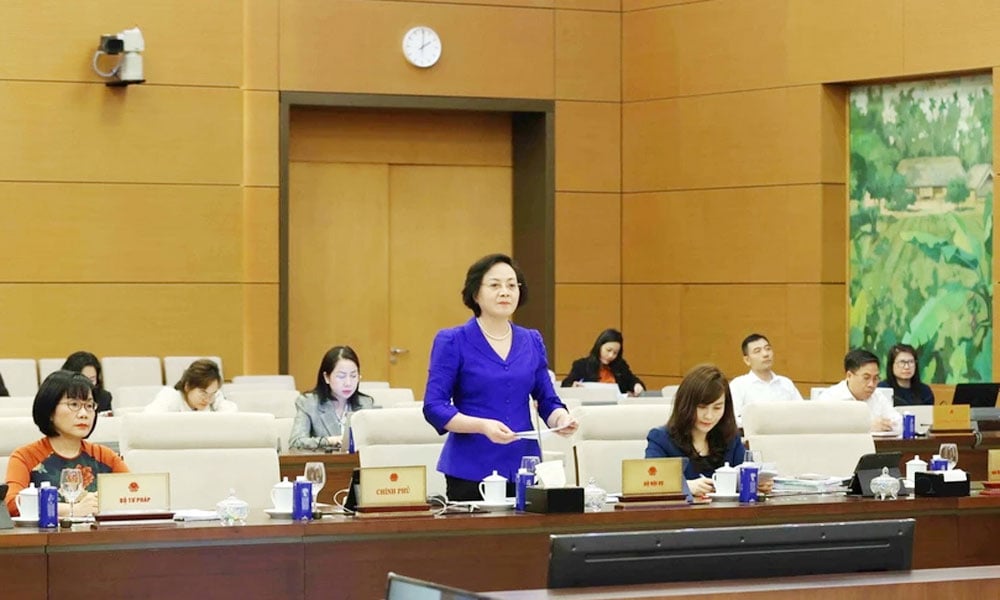 |
Minister of Home Affairs Pham Thi Thanh Tra presented the Report at the meeting. |
Responding to the need to organize government closer to the people, serving the people best
The arrangement of provincial-level administrative units stipulated in this Resolution is the merging of provinces with provinces to form new provinces or the merging of provinces with centrally run cities to form new centrally run cities according to the arrangement orientation approved by competent authorities to reduce the number, increase the scale of administrative units, expand development space, and maximize the potential and advantages of localities.
The arrangement of commune-level administrative units stipulated in this Resolution is the establishment, dissolution, merger, division of administrative units, and adjustment of the boundaries of commune-level administrative units to ensure appropriate quantity and scale, the whole country reduces the number of commune-level administrative units by about 60-70% compared to the present, meeting the requirements of organizing local government at the commune level close to the people, operating effectively, efficiently, and effectively. In case of arranging wards with administrative units of the same level, the administrative unit formed after the arrangement is the ward; in case of arranging communes and towns, the administrative unit formed after the arrangement is the commune.
Regarding the principles of administrative unit arrangement, the Resolution stipulates: Ensuring the leadership of the Party and enhancing the leadership and direction role of heads of agencies and organizations in implementing administrative unit arrangement. The arrangement of administrative units must comply with the Constitution, in accordance with the provisions of the Law on Organization of Local Government and this Resolution.
In case the arrangement of administrative units is in accordance with the orientation approved by competent authorities, it is assessed as being in accordance with the relevant planning approved by competent authorities.
The arrangement of provincial and commune-level administrative units is carried out for administrative units whose natural area or population size does not meet the standards of the corresponding administrative unit prescribed in Resolution No. 1211/2016/UBTVQH13 dated May 25, 2016 of the Standing Committee of the National Assembly on standards of administrative units and classification of administrative units, which has been amended and supplemented by a number of articles according to Resolution No. 27/2022/UBTVQH15 dated September 21, 2022 of the Standing Committee of the National Assembly (Resolution of the Standing Committee of the National Assembly on standards of administrative units and classification of administrative units); have similar historical and cultural traditions; have adjacent geographical locations; have appropriate scale, potential, advantages and level of economic development.
The development of plans for the arrangement of provincial and communal administrative units must take into account factors related to natural conditions, traffic infrastructure, distribution and organization of economic spaces to ensure maximum promotion of the potential and advantages of economic development of each locality, and mutual support to promote the overall socio-economic development of the administrative unit after the arrangement.
Along with that, carefully consider factors related to the level and management capacity of local Party committees and authorities, the level of digital transformation, application of information technology by local authorities and people; ensure requirements on national defense and security, build solid defense zones in key areas, island areas, archipelagos and border areas; preserve and promote historical, cultural and ethnic traditions of each locality; ensure solidarity of the community.
In case of implementing the arrangement of commune-level administrative units that changes the boundaries of district-level administrative units, it is not necessary to follow the procedures for adjusting the boundaries of the district-level administrative units to which the commune-level administrative units belong.
Linking the arrangement of administrative units with innovation, reorganizing the apparatus of the political system to be streamlined, effective and efficient; promoting decentralization, delegation of power, enhancing autonomy and self-responsibility of local governments; restructuring and improving the quality of cadres, civil servants and public employees; ensuring that local governments at the commune level are close to the people and serve the people best.
When implementing the arrangement of administrative units according to the provisions of this Resolution, the standards on structure and level of socio-economic development, number of affiliated administrative units, urban type, level of urban infrastructure development shall not be applied to administrative units formed after the arrangement. At the same time, it is necessary to focus on and do a good job of propaganda and mobilization of the people to create consensus, support and high unanimity on the policy of arranging administrative units.
The Resolution clearly states: No arrangements will be made for administrative units with isolated locations or locations of special importance related to national defense, security, and protection of national sovereignty.
The local government at the commune level after the arrangement will be put into operation no later than August 15, 2025.
According to the Resolution, the provincial administrative units formed after the rearrangement must meet the standards on natural area and population size of the corresponding administrative units as prescribed in the Resolution of the National Assembly Standing Committee on standards of administrative units and classification of administrative units. In case the province is oriented to become a centrally-run city, the province formed after the rearrangement must basically meet the standards on natural area and population size of a centrally-run city.
Based on the principles of administrative unit arrangement, the People's Committee at the provincial level is responsible for developing and selecting a plan to arrange commune-level administrative units suitable to the characteristics of rural, urban, island, mountainous, highland, border, plain, and ethnic minority areas and meeting the orientations.
Accordingly, mountainous and highland communes formed after the rearrangement have a natural area of 200% or more and a population size of 100% or more of the standards of the corresponding communes prescribed in the Resolution of the National Assembly Standing Committee on standards of administrative units and classification of administrative units.
Communes formed after the rearrangement are not subject to the above regulations and are not subject to the regulations on rearranging commune-level administrative units under district-level administrative units in islands, with a population size of 200% or more and a natural area of 100% or more of the corresponding commune standards prescribed in the Resolution of the National Assembly Standing Committee on standards of administrative units and classification of administrative units.
Wards formed after the rearrangement have a natural area of 5.5 km2 or more; for wards in centrally-run cities, the population must be 45,000 or more; wards in provinces formed after the rearrangement in mountainous, highland, and border areas must have a population of 15,000 or more; the remaining wards must have a population of 21,000 or more.
The arrangement of commune-level administrative units under district-level administrative units in islands must ensure national defense and security requirements and follow the orientation approved by competent authorities.
In case of arranging 3 or more commune-level administrative units into 1 new commune or ward, it is not necessary to consider the orientation of standards.
In case the commune-level administrative unit formed after the rearrangement cannot meet the standard orientations, the Government shall report to the National Assembly Standing Committee for consideration and decision.
Regarding the names of provincial and commune-level administrative units formed after the rearrangement, the Resolution stipulates: The names of provincial-level administrative units formed after the rearrangement shall be named after one of the administrative units before the rearrangement in accordance with the rearrangement orientation approved by competent authorities.
The name of a commune-level administrative unit must be easy to read, easy to remember, concise, systematic, scientific, consistent with the historical and cultural traditions of the locality and supported by the local people. It is encouraged to name the commune-level administrative unit in sequential numbers or according to the name of the district-level administrative unit (before the arrangement) with a sequential number attached to facilitate the digitization and updating of information data. The name of a commune-level administrative unit must not be the same as the name of an administrative unit of the same level within the scope of the provincial-level administrative unit or within the scope of the provincial-level administrative unit expected to be formed after the arrangement.
Regarding the arrangement and consolidation of the organizational apparatus of agencies and organizations after the administrative unit arrangement, the Resolution clearly states: Local authorities at commune-level administrative units after the arrangement must complete the organization and apparatus consolidation and officially come into operation no later than August 15, 2025.
Local authorities at provincial-level administrative units must complete the restructuring of their organizational structure and officially come into operation no later than September 15, 2025.
From the effective date of the Resolution of the National Assembly and the National Assembly Standing Committee on the arrangement of provincial and communal administrative units, the People's Councils and People's Committees in the previously arranged administrative units shall continue to operate until the People's Councils and People's Committees in the later arranged administrative units officially operate.
The Resolution also clearly stipulates the order, procedures, and documents for the project of administrative unit arrangement.
This Resolution comes into force from April 15, 2025.
Source: https://baobacgiang.vn/nghi-quyet-cua-uy-ban-thuong-vu-quoc-hoi-ve-sap-xep-don-vi-hanh-chinh-nam-2025-postid416133.bbg



![[Photo] The moment Harry Kane lifted the Bundesliga trophy for the first time](https://vphoto.vietnam.vn/thumb/1200x675/vietnam/resource/IMAGE/2025/5/11/68e4a433c079457b9e84dd4b9fa694fe)
![[Photo] Discover the beautiful scenery of Wulingyuan in Zhangjiajie, China](https://vphoto.vietnam.vn/thumb/1200x675/vietnam/resource/IMAGE/2025/5/11/1207318fb0b0467fb0f5ea4869da5517)
![[Photo] Prime Minister Pham Minh Chinh chairs the fourth meeting of the Steering Committee for Eliminating Temporary and Dilapidated Houses](https://vphoto.vietnam.vn/thumb/1200x675/vietnam/resource/IMAGE/2025/5/11/e64c18fd03984747ba213053c9bf5c5a)

![[Photo] National Assembly Chairman works with leaders of Can Tho city, Hau Giang and Soc Trang provinces](https://vphoto.vietnam.vn/thumb/1200x675/vietnam/resource/IMAGE/2025/5/11/c40b0aead4bd43c8ba1f48d2de40720e)
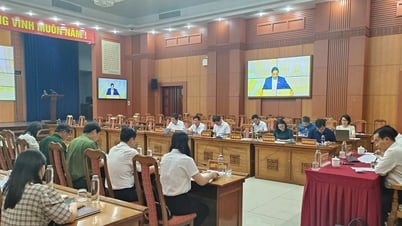
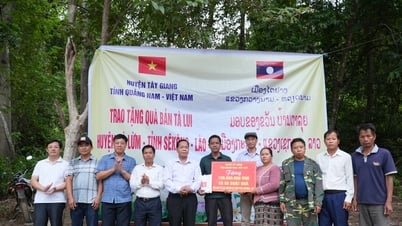



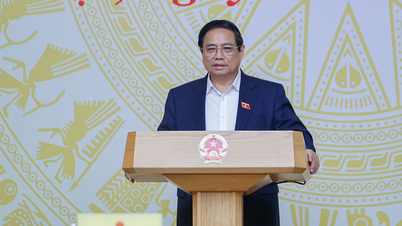











































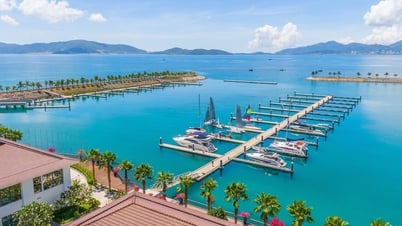































Comment (0)